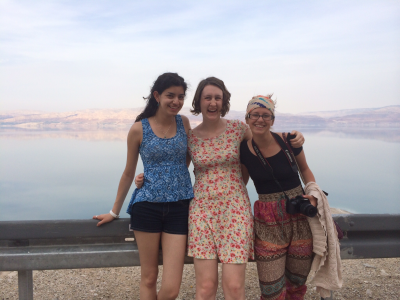The Dead Sea Scrolls and Qumran
alternatively titled: “Josephus, you’re wrong”
Seeing the Dead Sea Scrolls was one of the things that I was most looking forward to on this trip. On our first free day, a small group of us decided to revisit the Israel museum where I visited the Shrine of the Book exhibition for a second time.
Discovered at Qumran by accident in 1947 by a young shepherd, amongst 900 documents, the oldest known records of the Hebrew Bible are found in these scrolls, dating to the second century BCE. Apocryphal (such as the Epistle of Jeremiah) and pseudepigraphical (such as Enoch) texts as well as commentaries were found among these scrolls. This revisited the question of what was deemed canonical, particularly at the time these scrolls were written. These texts seem to have been produced by a community that was apocalyptic, expecting a heavenly and earthly battle of good and evil in the near future. For this reason, they were in a constant heightened state of purity.
The community greatly revered the Isaiah scroll, they may have been fulfilling the words of the prophet to go out into the wilderness to await God. This was probably related to a schism with mainstream Judaism and the priestly authority. Legislative documents detailing the practices and how the community should live as well as their War Scroll (detailing the battle between Good and Evil) are two unique scrolls that were found.
The Dead Sea Scrolls were associated with a group Josephus identified as the Essenes; a small all-male sectarian group with unique practices centered around many purification rituals and very strict rules. However, nowhere in the Dead Sea Scrolls does the community refer to itself by this name. Rather, they use the term Yachad meaning together—like an early monastery or kibbutz. By a thorough study of the texts, scholars have found references to “female elders/mothers/sisters/daughters”, which again shows that this group were not the Essenes Josephus talked about. The discovery of the Dead Sea Scrolls revolutionized the study of second temple Judaism and the Hebrew Bible, and has had a major influence on new critical texts of it.
While touring the exhibition on my own, I took advantage of the audio guide that was provided at the museum. It had the traditional audio which described the artifacts or scrolls presented, but it also had a short play which I was very disappointed that I couldn’t find online later. If I got the name correctly, it was Journey into the Desert; I felt like it was a very fun way to make the tour feel more interactive.
The site of Qumran itself presents its exhibition as a recreation of what the caves would have looked like to the archaeologists before the texts were deciphered and put into scholarship. It presents the community that wrote these texts and how they lived. These communities were spread out like cities, not isolated as Josephus describes them. Our guide talked about the different theories of where the scrolls really came from, presenting different bizarre speculations.
The material at Qumran was presented as being related to John the Baptist, giving it a theological context. The introductory video that was presented to us proposed that John the Baptist could have been a part of this community, although he didn’t become a full initiate. This would have been plausible because of the purifying ritual baths, which were used by the community. It could have been linked to the practice of baptism John used. Our guide called this area the “cradle of Christianity”: this was the geography of where the Jesus movement started. This possible link draws tourism not only of people interested in the Dead Sea scrolls, but also religious pilgrimage; which is something I didn’t know prior to visiting the site.
I could only imagine the community of people going out into the barren wasteland of the desert to live together to pray and prepare for the arrival of the Messiah.
Natalia Pochtaruk.

(This is not a picture of us at Qumran, but it is the Dead Sea at sunset, which located near the Qumran caves.)
“The Dead Sea Scrolls: Retrospective and Prospective” by Sidnie White Crawford, in Near Eastern Archaeology